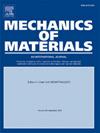A physics-based crystal plasticity model of nickel-based single crystal superalloy for different loading conditions under a wide temperature range
IF 4.1
3区 材料科学
Q2 MATERIALS SCIENCE, MULTIDISCIPLINARY
引用次数: 0
Abstract
Nickel-based single crystal (NBSC) superalloys are extensively used in the fabrication of turbine blades for aero engines, where their deformation behaviours play a critical role in ensuring flight safety. The deformation behaviours are governed by complex micro-scale mechanisms, such as matrix slip, precipitate shearing, interface dislocation pile-up, dislocation climb, coarsening, and rafting. However, many existing models either inadequately account for the underlying deformation mechanisms or rely heavily on temperature-sensitive material parameters, both of which undermine their predictive accuracy and generalizability under diverse loading and thermal conditions. To address these limitations, this study develops a robust and versatile crystal plasticity model that incorporates the above mechanisms. The model decouples temperature effects from constitutive parameters to mitigate parameter sensitivity to temperature variations. Additionally, a parameter decoupling strategy is employed to reduce the number of adjustable parameters and facilitate their identification. The model is validated against experimental data for the DD6 superalloy under uniaxial tension, creep, and low-cycle fatigue tests conducted across a wide temperature range (20–980 °C). The predicted mechanical responses demonstrate good agreement with the experimental results. Finally, the model is applied to simulate the mechanical behaviour of a specimen with inclined cooling holes. The model gives a nearly linear response of creep displacement, which matches well with the experiments.
基于物理的镍基单晶高温合金在宽温度范围内不同加载条件下的晶体塑性模型
镍基单晶高温合金广泛应用于航空发动机涡轮叶片的制造,其变形行为对保证飞行安全起着至关重要的作用。变形行为受基体滑移、析出相剪切、界面位错堆积、位错爬升、粗化和漂流等复杂微观机制控制。然而,许多现有的模型要么不能充分考虑潜在的变形机制,要么严重依赖于温度敏感的材料参数,这两者都破坏了它们在不同载荷和热条件下的预测准确性和通用性。为了解决这些限制,本研究开发了一个包含上述机制的健壮且通用的晶体塑性模型。该模型将温度效应与本构参数解耦,降低了本构参数对温度变化的敏感性。此外,采用参数解耦策略减少了可调参数的数量,便于辨识。该模型通过DD6高温合金在单轴拉伸、蠕变和宽温度范围(20-980°C)下的低周疲劳试验数据进行了验证。预测的力学响应与实验结果吻合较好。最后,将该模型应用于具有倾斜冷却孔的试样的力学行为模拟。该模型给出了蠕变位移的近似线性响应,与实验结果吻合较好。
本文章由计算机程序翻译,如有差异,请以英文原文为准。
求助全文
约1分钟内获得全文
求助全文
来源期刊

Mechanics of Materials
工程技术-材料科学:综合
CiteScore
7.60
自引率
5.10%
发文量
243
审稿时长
46 days
期刊介绍:
Mechanics of Materials is a forum for original scientific research on the flow, fracture, and general constitutive behavior of geophysical, geotechnical and technological materials, with balanced coverage of advanced technological and natural materials, with balanced coverage of theoretical, experimental, and field investigations. Of special concern are macroscopic predictions based on microscopic models, identification of microscopic structures from limited overall macroscopic data, experimental and field results that lead to fundamental understanding of the behavior of materials, and coordinated experimental and analytical investigations that culminate in theories with predictive quality.
 求助内容:
求助内容: 应助结果提醒方式:
应助结果提醒方式:


